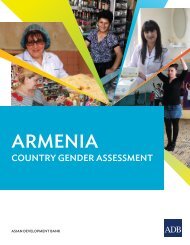Civic Activism as a Novel Component of Armenian Civil Society
English-3
English-3
You also want an ePaper? Increase the reach of your titles
YUMPU automatically turns print PDFs into web optimized ePapers that Google loves.
while actual and potential activists are a relatively smaller but more heterogeneous group <strong>of</strong><br />
people <strong>of</strong> various ages and walks <strong>of</strong> life. Not all <strong>of</strong> them are reachable through the Internet.<br />
Figure 5 Partial overlap between internet users and activists<br />
Frequent Internet users<br />
Actual and potential activists<br />
Not reached through<br />
internet<br />
4.3. Summing Up: Attitudes and Participation <strong>of</strong> the Broader Public<br />
The picture <strong>of</strong> <strong>Armenian</strong> political culture, depicted by the survey data discussed in this chapter,<br />
is not very encouraging for emerging civic initiatives, but there are some positives. Factors that<br />
are potentially negative include low public confidence in social movements, extremely low<br />
membership in formal and informal organisations, and public attitude towards politics and<br />
political participation. People are disinterested in politics, even more so than in the early years <strong>of</strong><br />
the newly independent RA. Given that attitude, it is probably a clever tactic for various<br />
<strong>Armenian</strong> civic initiatives to frame their activities <strong>as</strong> strictly non-political.<br />
Non-conventional political participation w<strong>as</strong> less common in 2011 than in 1997, but the<br />
heterogeneity <strong>of</strong> the participants had incre<strong>as</strong>ed: in 1997, young, educated males with lower<br />
incomes were more likely to sign petitions and partake in boycotts, demonstrations and strikes.<br />
In 2011, age, gender and income levels no longer have predictive power. Education remains<br />
important: the higher the education level, the higher is the likelihood <strong>of</strong> participation.<br />
Among the findings that can be interpreted <strong>as</strong> good news for civic activism is the fact that<br />
confidence in social movements h<strong>as</strong> incre<strong>as</strong>ed since the mid-1990s. Volunteering is on the rise.<br />
TV remains the main information source, but the Internet is spreading rapidly. One-third <strong>of</strong> the<br />
population uses social networking cites <strong>as</strong> sources <strong>of</strong> information about social and political<br />
events, making social networks a good venue for civic mobilisation. Drawing parallels between<br />
social media users and potential activists, we can see that social media reaches younger, more<br />
educated and financially better-<strong>of</strong>f people, while potential activists come from all walks <strong>of</strong> life.<br />
32



